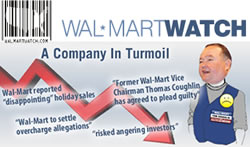New Orleans Wall Street analysts need to put our WARN (www.warnwalmart.org) on speed dial.
Reading the Wall Street Journal over the last week, as they speculated on whether or not big investors could convince the company to concentrate on “same store” sales and other stock enhancements, we could have told them in advance that Wal-Mart was already pulling back on expansion, walking away from applications, and putting new projects on hold. We could see it all over central Florida. We could have been invaluable to speculators looking for “inside” information, because we could hear and see the elephant lumbering in a different direction way before the meeting with the analysts.
Achieving virtual monopolistic control from supply to distribution to stores while seeking to gain total saturation of key markets as been the core business model for Wal-Mart for decades, so backing away from such ambition and domination would be a central shift for the company. Such a move would also accelerate overseas expansion, which was clearly reflected in the recent billion dollar purchase of a chain of supermarkets in China to increase Wal-Mart’s reach in this huge market.
In the past Wal-Mart has been willing to accept some cannibalization of sales growth from existing stores in order to achieve overall market share based on maximum convenience and accessibility. The point was to squeeze the competitors out of the market and limit choice for consumers to Wal-Mart. Furthermore, this business model was working as one could see over a 10 year period of rapid expansion in the Dallas-Fort Worth metroplex or Oklahoma City where the company had moved to 30% market shares and continued to increase the pressure.
There has always been an appropriate question about whether such a model was sustainable over term regardless of how well it might be working now. Wal-Mart clearly believed that if they controlled the market even if one store went down, they could push the consumer into another store easily enough, so that the construction and land costs were simply variables once market saturation was achieved. It is an interesting irony that the inability of Wall Street investors to “get” the rapaciousness of the business model and the residue of decades of Wal-Mart arrogance in selling its mission, is forcing the company to stand down from its business model.
For us though there is blood in the water now and, frankly, Wal-Mart with another business model is a Wal-Mart with no business model at all. This could be the beginning of the end for this company and its vision of American market dominance. There is still room to grow around the world, if they can figure that out from country to country (though what they have learned in Korea and Germany is unclear other than how to catch the plane out!), but we all may be able to mark this date as the beginning of the end for Wal-Mart as we have known it.
Who could have ever guessed that Wall Street would have been such a great ally?
October 24, 2006
